528th Support Battalion (United States)
528th Support Battalion was transformed into the Brigade Troops Battalion (Airborne) on 2 December 2005. It was formed by redesignating the 13th Support Battalion 16 May 1987 and organized into three companies: HQ, A, and B. The lettered companies were formed as forward support units. On 8 December 2008 it was redesignated as the 528th Special Troops Battalion (Special Operations) (Airborne) under the 528th Sustainment Brigade (SO) (A).
| 528th Support Battalion | |
|---|---|
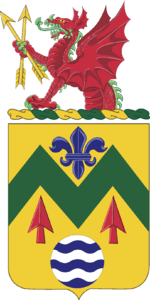 | |
| Country | United States |
| Branch | U.S. Army |
| Garrison/HQ | Fort Bragg |
| Insignia | |
| Distinctive unit insignia | 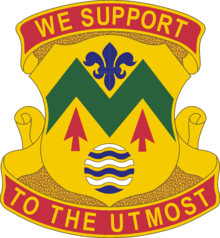 |
| Beret flash | 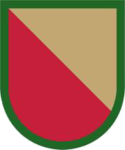 |
| 1st Special Forces Command (Airborne) shoulder sleeve insignia, worn by all subordinate units[1] | .png) |
| Former combat service identification badges | 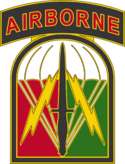 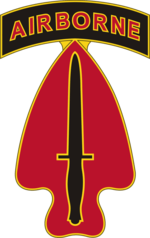 |
Overview
As part of Army Special Operations Command the unit, along with the 112th Signal Battalion, is tasked to provide full logistical support to Army Special Operations Forces forming along with several other units what was known as Special Operations Support Command, later reorganized as the 528th Sustainment Command. The Brigade Troops Battalion includes a wide variety of military occupation specialists: riggers, drivers, medics, mechanics, engineers, fuelers, cooks, etc.
History
Operation Iraqi Freedom[2]
Bravo Forward Support Company (BFSC), 528th Special Operations Support Battalion, supported the Combined Joint Special Operations Task Force -North (CJSOTF-N) Task Force Viking located in Mihail Kogălniceanu International Airport Romania and Irbil, Iraq. The Company's meritorious achievements in connection with operations in support of the Global War on Terrorism and OPERATION IRAQI FREEDOM were simply outstanding. Leading Direct Support (DS) vehicle and equipment maintenance, Supply Support Activity, medical support, sick call operations, water purification and distribution, Laundry and Bath, DS aviation refueling operations, Bare Base Engineering and power distribution, movement control operations and tasking management are just some of the notable accomplishments of the company. Upon arrival in Iraq, there were no fixed facilities available for the JSOTF BFSC RSOI and Bare Base elements rapidly established an entire working and living infrastructure for 2400 personnel in a matter of days. Once the unit landed in Irbil Iraq, BFSC's Base Support Platoon immediately began clearing land, erecting tents, building floors and multiple other construction projects. The units' Base Support Platoon proved to be a critical combat multiplier for the entire operation. By the end of the deployment, BFSC Engineers, electricians, carpenters, and ECU and Generator mechanics completed over 250 separate Jobs. On D-Day minus four, the company Supply and Service Platoon infilled two Fuel System Supply Points into northern Iraq vicinity Bashur and As Sulaymaniyah. This mission marked the first Combat Service Support Unit to enter the Iraqi theater of operations. Establishing this contingency bulk fuel storage site deep inside Northern Iraq was instrumental in the accomplishment of Combat Search and Rescue missions and Special Reconnaissance Infils. Later in the conflict, these fuel farms established a critical re-supply point for the 352nd Special Operations Group, the 26th Marine Expeditionary Force, and the 101st Airborne division. On one critical mission, the Al Sulaymaniyah operation fueled a beleaguered MC-130 so it could exfil from the theater of operations. The Bashur fuel team had already pumped 33,000 gallons to Special Operation Helicopters when the 173rd Airborne Brigade parachuted onto the airfield. By the end of the war, BFSC had received and issued over 350,000 gallons of JP-8 fuel from every conceivable source, including Air Force C-17, SOG MC-130 Wet wing, and GLOC fuel from Turkey. Supply support was especially critical during the initial phases of OPERATION IRAQI FREEDOM. Initially, all available sustainment airlift was consumed with building a basic stockage level of rations and bottled water for the task force. BFSC played a critical role in advising the CJSOTF Commander and his staff on which quantities and types of supplies should be prioritized. Once the necessary communications systems were in place, the company quickly established links to the theater army material management center. This enabled the JSOTF units to order supplies using the automated supply system (SARSS). By the end of the conflict, over 6.4 million dollars of supply requests had been processed and the supply support activity had processed over 200 pallets of equipment and supplies for issue. In February 2003, Bravo 528th deployed a movement control team to Fort Carson, CO to provide movement expertise to the 10th Special Forces Group as it prepared to deploy to Operation IRAQI FREEDOM. The Transportation platoon coordinated the movement of 18 chalks of C17s and prepared BFSC 528th SOSB for deployment to Turkey. Subsequently, a team deployed to an ISB in Stuttgart, Germany where they rapidly established an MCT from an ad hoc group of soldiers. Bravo 528th demonstrated great flexibility in redirecting cargo from Turkey to Romania after the Turkish Parliament declined a U.S. request to use its bases for operations. While managing the airfield in Stuttgart, the MCT uploaded more than 35 Air Force aircraft, exceeding 400 short tons of mission critical equipment needed for combat operations. Upon completing the mission in Germany, Bravo 528th deployed to Constanta, Romania, where it established an A/DACG and became the key player in airfield operations. The company formed a logistical bridge between the Air Force TALCE and supported units of CJSOTF-N. Using the seasoned organic MCT, they trained 10 additional soldiers who then flawlessly operated an A/DACG that normally requires an entire company to run. Through long hours and hard work, the transportation platoon managed the reception of 73 C17s, 32 C130s, 10 C5s and 4 L100s, as well as a variety of commercial aircraft. The MCT supervised the off load of over 3250 short tons: 460 pallets and ISU containers, 500 pieces of rolling stock and over 1000 passengers. From Romania, Bravo 528th masterfully orchestrated CJSOTF-N's movement to Iraq as the lead element of a Joint Movement Control Center. The MCC assessed the situation, took charge, established the standard, and managed 59 chalks of C17s destined for combat. The MCC moved 2300 short tons of combat equipment and sustainment packages to Bashur, Iraq in its role as the only DS transportation executor available to CJSOTF-N, BFSC led and planned the strategic movement for three Special Forces battalions, an Air Force Special Operations group, a coalition Special Forces squadron, a light infantry battalion and multiple support assets in areas outside US control under combat conditions. Once in the enemy's backyard, the transportation platoon was the single link between the CJSOTF-N and its logistical lifeline. Bravo 528th truck squads acted as the critical link from the ports of debarkation to the CJSOTF-N for both ALOCs and GLOCs. BFSC trucks made countless convoys to Bashur, Mosul, Kirkuk, and Al Sulaymaniah, Iraq
Current Status
When it redesignated into the 528th Special Troops Battalion (SO) (A) it reorganized to contain the Headquarters and Headquarters Company (HHC) and the Special Operations Medical Detachment (SOMEDD). The SOMEDD is currently aligned to contain three Special Operations Resuscitation Teams (SORT), the teams consist of a flight surgeon, an emergency nurse, three special operations combat medics, a laboratory technician, a radiology technician and a patient administration clerk. The SORT is a robust medical team that is capable of providing expeditionary, combat health support along with prolonged field care through CASEVAC of opportunity and also offering advanced trauma and resuscitative care with holding and CASEVAC management. The SORT is conceived as being adaptive and modular to provide forward support for SOF in austere locations. The SOMEDD also contains medical logistic, medical maintenance and dental assets.
Important dates
Throughout its short history the battalion was inactivated, reactivated, and redesignated numerous times. Officially it was constituted on 4 December 1942 in the US Army as Headquarters and Headquarters Detachment (HHD), 528th Quartermaster Service Battalion and then activated on the 15th of same month at Camp McCain, MS. Further important dates are listed below:
- 18 Jan 1944 – HHD 528 QB (Quartermaster Battalion)
- 24 May 1946 – HHD 528 QB (M) (Mobile)
- 1 Aug 1946 – HHD 528 Transportation Corps Truck Battalion (TCTB)
- 1 Feb 1947 – HHD 528 QB
- 20 Nov 1947 – Inactivated (France)
- 12 Oct 1948 – HHD 426 QB allotted to Organized Reserve Corps (ORC) and assigned to the 2nd Army
- 22 Oct 1948 – Activated at Clarksburg, WV
- 8 Nov 1950 – Inactivated (West Virginia), withdrawn from ORC
- 15 Jan 1952 – HHD 528 QB allotted to the Regular Army
- 1 Feb 1952 – Activated at Camp Atterbury, IN
- 5 Nov 1966 – Inactivated (Virginia)
- 5 Sep 1969 – HHD 528 QB reorganized
- 25 Sep 1969 – Activated at Phu Bai, Vietnam
- 15 Apr 1971 – Inactivated (Vietnam)
- 3 Jun 1986 – 13 SB organized and consolidated with
- 16 May 1987 – 528 SB redesignated
- 1 Nov 1995 – 528 SOSB (A) allotted to SOSCOM
- 2 Dec 2005 – Inactivated at Fort Bragg; assets succeeded to the Brigade Troops Battalion (Airborne)[3]
Campaign participation credit
World War II
Sicily(Arrowhead)
Rome-Arno
Southern France(Arrowhead)
Rhineland
Ardennes-Alsace
Central Europe
Vietnam
Summer-Fall 1969
Winter-Spring 1970
Sanctuary Counteroffensive
Counteroffensive, Phase VII
Southwest Asia
Defense of Saudi Arabia
Liberation and Defense of Kuwait
Decorations
Joint Meritorious Unit Award, Streamer embroidered HAITI
Joint Meritorious Unit Award, Streamer embroidered PANAMA
Valorous Unit Award, Streamer embroidered IRAQ-KUWAIT (17 Jan. 1991 – 28 Feb. 1991, DAGO 14, 1993, DAGO 12, 1994)
Distinctive unit insignia
The insignia is the shield and motto of the coat of arms. The insignia was authorized for wear on 14 Jan. 1988
- Blazon
- Shield: Or, a dance of two vert between a fleur-de-lis and two arrowheads gules, in base a fountain
- Crest: On a wreath of the colors (or and vert) a semi-oriental winged dragon gules, armed and langued vert, grasping two arrows saltirewise of the first
- Motto: We Support to the Utmost
- Symbolism: The heraldic dance is reminiscent of mountains while the fountain represents water. The fleur-de-lis is for France. These elements represent the service of the unit in Europe during World War II. The unit's two assault landings are indicated by the red arrowheads while the green refers to the organization's mission of support to Special Operations. The unit's service in Vietnam is symbolized by the dragon. Its wings and the crossed arrows refer to the battalion's mission and capabilities.
Chain of command
On the picture below 528 is on the far-right branch of the chain.

See also
- Special Operations Support Command
References
- 528th Sustainment Brigade (SO) (A) Patch Change Ceremony, Defense Visual Information Distribution Service, by SGT Vance Williamson, dated 5 April 2017, last accessed 9 July 2019
- "Logistical Support to Task Force Viking: Task Force Support in Northern Iraq". www.soc.mil. Retrieved 31 July 2019.
- From Army News at Army web-site